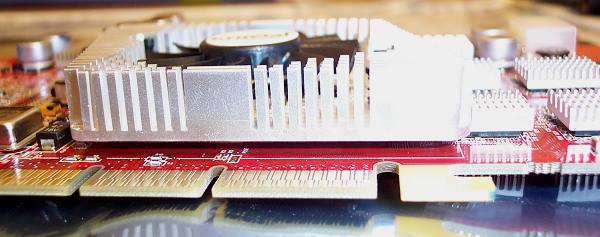Card appearance
The design change from Radeon 9800 Pro to 9800XT centered around a smaller PCB and larger, copper-based cooler. The Crucial 9800 Pro 256MB card, however, stuck firmly with the reference design of the time.
It's longer than the 9800XT by around 3cm. The other notable difference between the 128B and 256MB PRo models, save for the extra onboard RAM running 20MHz faster, was the inclusion of factory-fitted RAMsinks. They add a touch of class and help cushion the near-£300 asking price. Crucial's 9800 Pro 256MB card has a clean about it. You can't help but think ATI's 9800XT has the better cooler design. A picture of the back of the card, replete with those flashy RAMsinks, can be found here.

The Pro's is flimsy in comparison, so much so that our review sample was sitting perilously loosely on the GPU. Just a few ounces of force was enough to shift its position. We're from the school of though that prescribes an ultra-firm contact between GPU and cooler. The same fitting accusations cannot be levelled at the RAMsinks, as they're attached on in meticulous fashion. The extra cooling afforded by the RAMsinks is open to question; it seems like an aesthetic measure more than a performance initiative.

ATI and its partners, in a bout of justification for the extra £75 or so charged for the 256MB model, decided to increase the onboard memory's speed to 700MHz DDR by using some new-fangled DDR2 memory. Crucial's card uses a 256-bit wide memory bus that offers up a potential 22.4GB/s of bandwidth. That's 20MHz or ~ 0.64GB/s greater than a 128MB model's. The engine speed, though, has remained fixed at 380MHz. ATI also decided to keep the 0.15-micron fabrication intact from the 9700 Pro, which it has kept rolling with the 9800XT's 412MHz core clock. That means heat and the need for auxilary power. The ever-present molex power connector is an indictment of the power requirements of top-end cards. Present motherboards' AGP slots, it's deemed, can't supply the necessary wattage.
In stark contrast to NVIDIA's high-end cards, ATI's appear to be bereft of decent VIVO ability. ATI and Crucial may argue that there's an All-In-Wonder model that's best suited to that job, but we feel too many 9800 Pros aren't exploiting the all-around potential that £300 of your money deserves. The user, in this case, has to settle for basic TV-Out, limited to 1024x768.

Standard hookups here. We still lament not being able to do everything with a pricy 3D accelerator.









